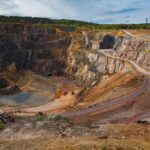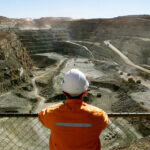Energy News Beat
Key Takeaways
An expected surplus of copper going into 2024 has suddenly all but disappeared as a series of large new mineral projects that were scheduled to start up around the world are facing problems. Instead of the surplus, the mining industry’s supply has dwindled due to political and social opposition, the difficulty of developing new operations, and the day-to-day challenge of mining. In the past two weeks, one of the world’s biggest copper mines was ordered to close due to public protests, and operational problems has forced one of the leading mining companies to cut its production forecasts. This is another setback for the Biden administration since copper is an essential metal needed to reach net zero carbon dioxide.
Despite mining companies being key to facilitating the shift to green energy, President Biden has stood in the way of expediting that industry in the United States. He has revoked mining leases, delayed or denied permits, and listed fauna and flora as endangered, stopping mines cold in many cases in Minnesota, Arizona and Alaska. The “electrify everything” aspect of Biden’s climate promises cannot be done without copper. The International Energy Agency has warned that minerals shortfalls would lead to a slower energy transition.
Panama Closes Copper Mine
Last week, Panama’s government ordered First Quantum Minerals Ltd. to end all operations at its $10 billion copper mine. The order followed weeks of protests and political controversy that came to a head when the country’s Supreme Court invalidated the law that underpinned its mining license. The Cobre Panama copper mine can produce about 400,000 tons of copper a year, if allowed to operate. The Cobre Panama copper mine has been in production since 2019. It generated 112,734 metric tons of copper in the third quarter of 2023, contributing $930 million to First Quantum’s overall third-quarter revenue of $2.02 billion. The mine accounts for about 5 percent of Panama’s gross domestic product and makes up 75 percent of its exports. Cobre Panama has requested government authorization to lay off more than 4,000 of its employees. Last month, the mining company suspended the contracts of 7,000 staff at the mine.
Copper Producer Cuts Production
Anglo American Plc announced that it will cut production from its copper business in South America to reduce costs amid logistical and operational problems. Anglo American is cutting capital expenditures by $1.8 billion by 2026 due to a fall in demand for most of the metals it mines and a write down for its British fertilizer project, which failed despite its low carbon dioxide impact. The miner will reduce expenditures by $500 million this year and another $500 million next year. While Anglo has had issues with its platinum and iron ore operations in South Africa, the biggest and most surprising cuts are at its copper business in South America.
Anglo lowered its 2024 output target for copper to between 730,000 tons and 790,000 tons, from 1 million tons, reducing its copper production target for next year by about 200,000 tons, which essentially removes the equivalent of a large copper mine from global supply. Its production is expected to fall further in 2025, before starting to increase again the following year. The company’s biggest problem is its Los Bronces mine in Chile. Like many of the industry’s biggest copper mines, the operation is more than 100 years old and Anglo is now struggling with hard ore that contains low grades of metal. Rather than mine this expensive-to-process ore, the company is waiting until it can blend it with higher grade material, which will take several years to develop. Anglo’s production will be about 4 percent lower next year, and it will fall another 3 percent in 2025.
Anglo has not been the only company reporting lower profits. Rio Tinto, Teck Resources and Glencore have reported lower profits and returns in the first half of the year, as lackluster economic growth hit commodity prices.
BMO Capital Markets, which was forecasting a large surplus of refined copper next year, now expects a small deficit. Goldman Sachs Group Inc., which has been bullish on copper and had already forecast a deficit of refined metal for 2024, now expects that shortfall to be more than half a million tons. Jefferies Financial Group also expects a major deficit next year.
Market Expectations
The sudden removal of around 600,000 tons of expected supply will move the market from a large expected surplus into either balance or deficit. While the price reaction to the supply disruptions has so far been muted, any demand recovery would hit a tight market. The expectation for a looser market in the near term has weighed on prices for much of this year, leaving copper drifting sideways.
The International Copper Study Group still expects a surplus of 467,000 tons for next year, which it set at its meeting in early October — its largest forecast for a glut since 2014—and a significant upward revision from the expected 297,000-metric ton surplus from the Group’s forecast in April. The Group, however, still expects the market to be in deficit this year but only for about 27,000 metric tons, which is small relative to a 26-million metric ton annual global market.
Biden’s Warpath on Mining in the U.S. Includes Copper Mines
The Pebble mine in Alaska, the Twin Metals and Poly Met mines in Minnesota and the Rosemont and Resolution mines in Arizona are either in limbo or have been denied permits by the Biden Administration. In January 2022, the Biden administration revoked the federal leases for the Twin Metals mine in Minnesota that contains copper, nickel, cobalt, and platinum-group elements. The Poly Met copper and nickel mine also in Minnesota has had problems obtaining three needed permits from Biden’s federal agencies.
The Pebble copper and gold mine, 100 miles from Bristol Bay, Alaska, had its permit application rejected in November 2020 by the Army Corps of Engineers and had requested that decision to be reversed when Biden took office. In January 2023, Biden’s EPA issued a final determination under the Clean Water Act that bans the disposal of mine waste in part of the bay’s watershed. Only three such negative determinations were issued in the past 30 years.
The Rosemont copper mine in northern Arizona received a setback when Biden’s federal regulators rejected its mining company’s request to reduce critical habitat for jaguars deemed endangered on land that overlaps the footprint of the proposed mine. Hudbay Minerals Inc. had been working for more than a decade to open the mine that needed only about 6 percent of the land that had been excluded for the jaguars.
The Resolution copper mine in Oak Flat, Arizona, which can meet about 25 percent of U.S. copper demand, had approval rescinded by the Biden administration days before thousands of acres of federal land was to be transferred for the project. The land could have been handed over under a congressionally approved swap in which the federal government would trade 2,422 acres of land to Resolution Copper in exchange for 5,459 acres of other land in southeast Arizona. In 2014, the U.S. Congress approved the land trade, but it required an environmental report to be published, which the Trump administration did shortly before President Trump left office. President Biden unpublished that report in March 2021 and had his administration re-review concerns from Native Americans. Biden’s Forest Service has told a federal court it is not sure when it could approve a land swap allowing the Resolution Copper mine to be developed. The case involves a long-running conflict between a mining company and Indigenous groups seeking to preserve Arizona’s Oak Flat campground by stopping the underground mine. The case is winding its way through several courts.
Conclusion
Once considered a glut, copper supplies are now seen as possibly in balance or in a deficit, which will hurt the green energy transition as copper is needed for electric vehicles and for renewable technologies. About 600,000 tons of copper have suddenly been cut from supply as Panama has issued the closure of a major mine and as a company with copper production in South America has cut its production. The United States has copper resources and could be helping the transition get the copper it needs, but President Biden’s administration has put a stop to several copper mines by revoking leases, denying and delaying permits, and listing species as endangered.
The post An Expected Surplus of Copper has Suddenly Disappeared appeared first on Energy News Beat.








